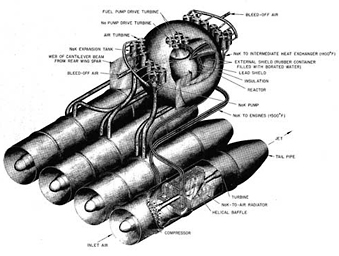coal2thorium .com  Repowering America
Repowering America
GENESIS
Site Map
Genesis of the Thorium-Powered
Liquid Reactor
Molten Salt Reactor:
The reactor technology path not taken.
A very light and very powerful
molten salt reactor was developed to power nuclear
bomber airplanes a few years
before Intercontinental Missiles were developed.
The NB-36 made nearly 50 flights in the 1950s
carrying an operating nuclear reactor. The crew worked from a
lead-shielded cockpit.
Thorium:
The nuclear energy path not taken.
By the time the Manhattan
Project was completed 3 viable nuclear energy paths were identified: Uranium,
Plutonium, and Thorium.
Thorium had very poor weapons potential and was subsequently abandoned and forgotten.


(Left) The
NB-36's "Fireball" reactor using dissolved uranium liquid fuel and
the 4 nuclear jet engines it powered. It has little in common with
today's solid core reactors.
(Right) The USS Nautilus got the first operational solid fuel nuclear reactor.
A major objection to nuclear airplanes was the
possibility of a crash in a large city.
Today's low temperature (550°F) solid fuel core
power plant reactors are massively scaled up versions of the first desk-size submarine solid-fuel core reactors.
They are not hot enough to duplicate the
efficient superheated steam coal makes in a
coal-burning power
plant. The very hot
(1,300°F) liquid fuel
core in airplane nuclear reactors can easily duplicate, and thus replace, any
any steam found in any coal or natural gas power plant.
(Right) The Molten Salt Reactor Experiment heat exchanger ran so hot it glowed like the burners on your kitchen range.
(Click on chart to prove to yourself how hot it was. The chart is in Kelvin, an
absolute temperature measurement. 1,300°F = 978 K )
Also:
 Color temperature
Color temperature
Liquid Reactors: May, 1946, marked the beginning of
the ultra-secret nuclear powered bomber program that eventually progressed as
far as the NB-36H bomber.
By 1955, this program
produced the successful X-39 jet engine - two modified General Electric J47
jet engines with reactor-heated heat exchangers replacing the standard jet engine's
jet fuel combustors - and
would probably have gone on to power the X-6 successor to the NB-36H had that program been
pursued. Nuclear powered airplane
programs were eventually abandoned in favor of far faster, more difficult to
intercept, intercontinental ballistic missiles.
The airplane engine's nuclear
reactor was extremely light, simple, fast
responding, powerful,
and hot enough to replace jet fuel. The uranium nuclear fuel, dissolved in molten salt,
flowed through the reactor and its heat exchangers much like energy-transporting
blood flows through the organs of animals. Unlike water, 1,300°F molten
salt produces no vapor pressure and, as a consequence, the reactor cannot
explode like conventional high pressure steam nuclear reactors.
Later, a slightly larger version
of the same type of reactor was built in the same aircraft reactor development
building at Oak Ridge National Laboratories. Completed in 1965, it was
called the "Molten Salt Reactor Experiment" (MSRE) and, over the next 5 years,
ran at full power for the equivalent of one and a half years.
Thorium: The
nuclear energy path not taken.
By the time the Manhattan Project was
completed, 3 viable nuclear energy paths were identified: Uranium, Plutonium, and
Thorium. Thorium had very poor weapons potential and was subsequently abandoned as
being suitable for weapons.
Later, along with uranium and plutonium, thorium was explored as a potential
reactor fuel in both solid fuel reactors (Shippingport, near Pittsburgh, PA) and liquid fuel reactors
(Oak Ridge Molten Salt Reactor Experiment - MSRE).
Unlike polyisotopic
uranium
(
http://en.wikipedia.org/wiki/Isotope ), thorium is monoisotopic and
therefore does not need costly enrichment to be used as nuclear fuel.
Several combinations of liquid reactors and thorium fuels appear to be ideal for
making cheap,
extremely hot heat for millions of years. Unlike solid fuel reactors
which cannot consume more than several percent of their uranium fuel before
becoming too weak to run, liquid fuel reactors are capable of almost completely
consuming their nuclear fuel, and, as a consequence, produce about 250 times the
heat and 1% the nuclear waste of a solid fuel reactor. Further, most of
this small amount of nuclear waste decays to a safe level in less than a decade,
the remainder in several hundred years.
This combination of running
coal-hot and load-following while making about 250 times as much heat and
producing 1% the waste - in a far less expensive to build reactor - attracted
great interest from the electrical utilities. Conceptual designs for large,
utility size molten salt reactors were on the drawing boards as early as 1960.
Today, heat
from thorium could be 8,000 times cheaper than heat from coal.
We have arrived at energy's final frontier where all
of civilization's heat must come from nuclear.
Burning our last remaining deposits of oil, natural gas, and coal will only make
Global Warming worse. The hydrocarbons in oil, natural gas, and coal are
far more valuable for bringing us good lives by using them as feedstock for
plastics and fertilizers rather than wasting them as mere sources of heat.
This book is about re-starting
America's thorium-fuelled molten salt reactor program using a modern version of
the 1972 EBASCO 1,000 megaWatt electricity generating plant reactor.
________________________________________________________________________________________
Oak Ridge National Laboratories is
a reputable organization and they have hundreds of documents about
several
experimental molten salt reactors, HTRE-1, HTRE-2, HTRE-3, and MSRE,
which ran for about 5 years, some of the time on liquid thorium.
Also, the Shippingport reactor
 ran for several years on solid thorium.
ran for several years on solid thorium.
The author knows of no reason to doubt the accuracy of these documents.
These documents may be found, examined, and downloaded without restriction at:
http://moltensalt.org/references/static/downloads/pdf/index.html Bruce
Hoglund's web site ORNL collection.
http://www.energyfromthorium.com/pdf/ Kirk Sorensen's web site ORNL
collection.
![]() ran for several years on solid thorium.
ran for several years on solid thorium.





